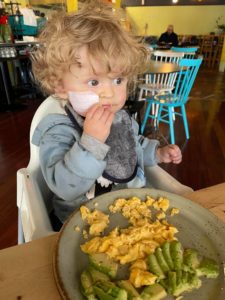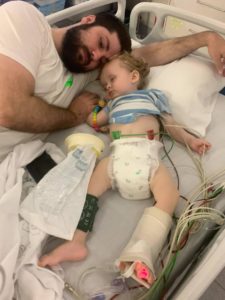This story was originally published in The Cystinosis Advocate, the newsletter for the Cystinosis Research Network, a Patient Worthy partner organization.
Continued From Part One
At this stage, the ED registrar thought it was possibly renal tubular acidosis. A nephrologist specialist happened to be working in ED that night and popped in and saw Oscar. It was mentioned to her that Oscar may have a kidney condition, however it wasn’t confirmed yet. We spent the night in ED waiting for a bed in the Paediatric Intensive Care Unit (PICU). The next morning, Oscar was taken to have his wrist x-rayed for rickets and we were rushed up to PICU as a bed was finally available. We spent seven days in PICU, which was truly the most devastating and scary moment in our lives. We were so very close to losing Oscar, as his levels of critical minerals were unable to be stabilized. His life was literally in the hands of the PICU team.
He was constantly vomiting, not being able to hold down any of the fluids or minerals in that were being pumped into him. The cannulas stopped working and we had to make the call to have a port put in his thigh. It was heartbreaking having to put your child through this and watch him be sedated by ketamine; all the while not knowing what was going on.
But this port was the thing that saved his life, and it allowed the PICU team to finally be able to treat him by monitoring his bloods continually. They were able to make the critical decisions as to what was needed to get him stable. It was also during this time that the specialist nephrologist who saw Oscar in ED was called into PICU to make the call as to whether Oscar was dealing with a genetic kidney condition. It was incredible timing as there was also a genetic trial available. We were able to have our bloods taken to confirm whether Oscar held the gene mutation for the genetic condition.

We didn’t realize it at the time that we were lucky to have had such a quick diagnosis, and now looking back we are extremely thankful for this as we know a lot of other families went through long ordeals with a lot of misdiagnoses. We had looked up earlier that Oscar may possibly have Fanconi syndrome, but missed the part where it said that Fanconi syndrome is often the first sign of cystinosis. It hit us hard when we realized what Oscar had and what it meant for his life. We were devastated for the life our little boy was meant to have. Having to consider your own child’s mortality was utterly heartbreaking and it broke us; that moment was life changing, and we as parents are not the same people we were before that diagnosis. It stays with you forever.
Continued in Part Three








